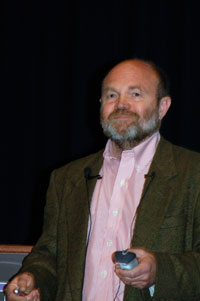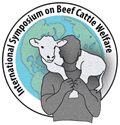Scientific Assessment of Animal Welfare
A risk assessment approach to animal welfare is becoming increasingly important.
MANHATTAN, Kan. (May 20, 2010) — Jeffrey Rushen provided an overview of the importance for scientific assessment of animal welfare to participants at the International Symposium on Beef Cattle Welfare May 20. Rushen is a researcher in dairy cattle welfare at the Agriculture and Agri-Food Canada Research Centre, in Agassiz, B.C., and an adjunct professor in the Animal Welfare Program at the University of British Columbia and at the University of Laval in Quebec.

Jeffrey Rushen encourages the beef industry to solve animal welfare problems while it has time to do so. Issues of indoor housing, muddy pens, transportation and pain of dehorning/castration need to be addressed.
Animal welfare is increasingly becoming a trade issue — particularly in Europe, where several mandates are already in place, Rushen said. The movement is gaining momentum with many international trading partners, such as Japan, China, Korea and Brazil.
He noted that many like to downplay the high animal care standards in Europe saying they are based on emotion rather than science. But Rushen said the Europeans are starting to build a very formal system of regulations based on science.
To that end, Rushen says a risk assessment approach to animal welfare is becoming increasingly important. He defined risk assessment as a generally accepted, repeatable, transparent and validated measurement.
“It’s a myth that pain cannot be measured in animals,” Rushen added. “Studies show us that pain control can be measured using anesthetics and analgesics.”
He also said, “Can we judge the emotions of animals? People are starting to do this.”
Noting this, Rushen encouraged the beef industry to solve animal welfare problems while it has time to do so. He noted that consumers still perceive the cow-calf industry as fairly favorable, with the image of cows on green grass. But he stated that issues like indoor housing, muddy pens, transportation, and pain of dehorning/castration are issues that need to be addressed.
“There is a broad agreement on many of the animal welfare practices,” Rushen noted in closing. “It’s just that different terms are being used.”
He also suggested that future science should start measuring the “positive” things animals experience on farms.
“As scientists we’ve been good with science to measure pain, disease, stress," he said. "I think people would feel more comfortable knowing about animals' play behavior and positive social relationships between animals.
“I think this is one of the directions that animal welfare needs to move," Rushen concluded. "It’s not all bad. There is some positive interaction, too.”
The beef cattle welfare symposium was conducted on campus at K-State University May 19-21. For additional presentation summaries, return to the Meetings > Other Industry Meetings > News Coverage page of the API Virtual Library. For more about the symposium and an archive to the 2008 symposium, visit www.isbcw.beefcattleinstitute.org.
Editor's Note: This article was written under contract or by staff of Angus Productions Inc. (API), which claims copyright to this article. It may not be published or distributed without the express permission of API. To request reprint permission and guidelines, contact Shauna Rose Hermel, editor, at 816-383-5270.

